Руководства Panasonic KX-TGA250RUS Размер файлов: 5185 KB, Язык: English, Формат: pdf, Платформа: Windows/Linux, Дата: 2017-03-15
На данной странице вы можете скачать руководства Panasonic KX-TGA250RUS. Мы предлагаем вам ознакомиться с руководством пользователя, инструкцией по сервисному обслуживанию и ремонту.
Также здесь вы найдете список заказных номеров на комплектующие Panasonic KX-TGA250RUS.
Все файлы предоставляются исключительно в ознакомительных целях. И не являютя руководством по ремонту, а направлены лишь на то чтобы помочь вам более детально ознакомиться с принципом построения устройства.
Содержимое представленных здесь руководств требуют от вас знания технического английского языка.
Если вы собираетесь скачать руководство по сервисному обслуживанию Panasonic KX-TGA250RUS, иными словами сервис мануал, вы дожны обладать хотя бы минимальными познаниями в области электроники и пониманием базовых принципов работы электромеханических устройств.
Для просмотра руководств вам понадобится Adobe Acrobat Reader версии 9 и выше либо другая программа для просмотра pdf файлов.
В связи с популярностью информации представленной на сайте и ее бесплатного предоставления конечному пользователю, убедительная просьба использовать специальные программные продукты для многопотокового скачивания файлов.
Руководства для Panasonic KX-TGA250RUS
- Руководство пользователя (User manual)
- Руководство по сервисному обслуживанию (Service manual)
- Руководство по ремонту (Repair manual)
- Перечень комплектующих (PartList)
Page 28: Remote Commands, Using The Answering System, Turning On The Answering. За два месяца от владельцев переделанных аппаратов не поступило ни одной жалобы. Для того, чтобы аппарат отображал номер вызывающего абонента, необходимо подключить соответствующую услугу у оператора связи.


ORDER NO. KM41006113CE
Telephone Equipment
Model No. KX-TG2511CAM KX-TG2511CAS KX-TG2511CAT KX-TG2512CAM KX-TG2512CAT KX-TGA250RUM KX-TGA250RUS KX-TGA250RUT
Digital Cordless Phone
M: Metallic Grey Version
S:Silver Version
T:Titanium Black Version (for Kazakhstan)
(for Tajikistan) (for Uzbekistan) (for Turkmenistan) (for Kyrgyzstan)
© Panasonic System Networks Co., Ltd. 2010 Unauthorized copying and distribution is a violation of law.

KX-TG2511CA/KX-TG2512CA/KX-TGA250RU
2

TABLE OF CONTENTS |
||
|
PAGE |
||
|
1 |
Safety Precautions———————————————— |
4 |
|
1.1. For Service Technicians ——————————— |
4 |
|
|
2 |
Warning————————————————————— |
4 |
|
2.1. Battery Caution——————————————— |
4 |
|
|
2.2. About Lead Free Solder (Pbf: Pb free)————— |
4 |
|
|
2.3. Discarding of P.C. Board——————————— |
5 |
|
|
3 |
Specifications —————————————————— |
6 |
|
4 |
Technical Descriptions —————————————— |
7 |
|
4.1. Block Diagram (Base Unit) —————————— |
7 |
|
|
4.2. Circuit Operation (Base Unit)————————— |
8 |
|
|
4.3. Block Diagram (Handset)——————————- |
11 |
|
|
4.4. Circuit Operation (Handset)—————————- |
12 |
|
|
4.5. Circuit Operation (Charger Unit) ———————- |
13 |
|
|
4.6. Signal Route ———————————————— |
14 |
|
|
5 |
Location of Controls and Components —————— |
15 |
|
6 |
Installation Instructions ————————————— |
15 |
|
7 |
Operating Instructions—————————————— |
15 |
|
7.1. For Service Hint——————————————- |
15 |
|
|
8 |
Service Mode —————————————————— |
16 |
|
8.1. Engineering Mode —————————————- |
16 |
|
|
8.2. Copying Phonebook Items when Repairing ——- |
20 |
|
|
8.3. How to Clear User Setting—————————— |
22 |
|
|
9 |
Troubleshooting Guide—————————————- |
23 |
|
9.1. Troubleshooting Flowchart —————————— |
23 |
|
|
9.2. Troubleshooting by Symptom (Base Unit and |
||
|
Charger Unit) ———————————————- |
35 |
|
|
9.3. Troubleshooting by Symptom (Handset) ———— |
39 |
|
|
10 |
Disassembly and Assembly Instructions ————— |
43 |
|
10.1. Disassembly Instructions ——————————- |
43 |
|
|
10.2. How to Replace the Handset LCD ——————- |
46 |
|
|
11 |
Measurements and Adjustments————————— |
47 |
|
11.1. Equipment Required ————————————- |
47 |
|
|
11.2. The Setting Method of JIG (Base Unit) ————- |
47 |
|
|
11.3. Adjustment Standard (Base Unit)——————— |
49 |
|
|
11.4. Adjustment Standard (Charger Unit)—————— |
50 |
|
|
11.5. The Setting Method of JIG (Handset) ————— |
51 |
|
|
11.6. Adjustment Standard (Handset) ———————- |
53 |
|
|
11.7. Things to Do after Replacing IC or X’tal ———— |
54 |
|
|
11.8. RF Specification——————————————- |
56 |
|
|
11.9. How to Check the Handset Speaker or |
||
|
Receiver —————————————————- |
57 |
|
|
11.10. Frequency Table (MHz) ——————————— |
57 |
|
|
12 |
Miscellaneous —————————————————- |
58 |
|
12.1. How to Replace the Flat Package IC —————- |
58 |
|
|
12.2. How to Replace the Shield Case ——————— |
60 |
|
|
12.3. Terminal Guide of the ICs, Transistors and |
||
|
Diodes and Electrolytic Capacitors——————- |
62 |
|
|
13 |
Schematic Diagram ——————————————— |
63 |
|
13.1. For Schematic Diagram——————————— |
63 |
|
|
13.2. Schematic Diagram (Base Unit) ———————- |
64 |
|
|
13.3. Schematic Diagram (Handset) ———————— |
66 |
|
|
13.4. Schematic Diagram (Charger Unit) —————— |
68 |
|
|
14 |
Printed Circuit Board——————————————- |
69 |
|
14.1. Circuit Board (Base Unit_Main)———————— |
69 |
|
|
14.2. Circuit Board (Handset) ——————————— |
71 |
|
|
14.3. Circuit Board (Charger Unit) ————————— |
73 |
|
|
15 |
Exploded View and Replacement Parts List ———— |
74 |
|
15.1. Cabinet and Electrical Parts (Base Unit) ———— |
74 |
|
KX-TG2511CA/KX-TG2512CA/KX-TGA250RU |
|
|
PAGE |
|
|
15.2. Cabinet and Electrical Parts (Handset)————- |
75 |
|
15.3. Cabinet and Electrical Parts (Charger Unit) ——- |
76 |
|
15.4. Accessories———————————————— |
77 |
|
15.5. Replacement Part List ———————————- |
78 |
3

KX-TG2511CA/KX-TG2512CA/KX-TGA250RU
1 Safety Precautions
1.1.For Service Technicians
•Repair service shall be provided in accordance with repair technology information such as service manual so as to prevent fires, injury or electric shock, which can be caused by improper repair work.
1.When repair services are provided, neither the products nor their parts or members shall be remodeled.
2.If a lead wire assembly is supplied as a repair part, the lead wire assembly shall be replaced.
3.FASTON terminals shall be plugged straight in and unplugged straight out.
•ICs and LSIs are vulnerable to static electricity.
When repairing, the following precautions will help prevent recurring malfunctions.
1.Cover plastic parts boxes with aluminum foil.
2.Ground the soldering irons.
3.Use a conductive mat on worktable.
4.Do not grasp IC or LSI pins with bare fingers.
2 Warning
2.1.Battery Caution
1.Danger of explosion if battery is incorrectly replaced.
2.Replace only with the same or equivalent type recommended by the manufacturer.
3.Dispose of used batteries according to the manufacture’s Instructions.
2.2.About Lead Free Solder (Pbf: Pb free)
Note:
In the information below, Pb, the symbol for lead in the periodic table of elements, will refer to standard solder or solder that contains lead.
We will use PbF solder when discussing the lead free solder used in our manufacturing process which is made from Tin (Sn), Silver (Ag), and Copper (Cu).
This model, and others like it, manufactured using lead free solder will have PbF stamped on the PCB. For service and repair work we suggest using the same type of solder.
Caution
•PbF solder has a melting point that is 50 °F ~ 70 °F (30 °C ~ 40 °C) higher than Pb solder. Please use a soldering iron with temperature control and adjust it to 700 °F ± 20 °F (370 °C ± 10 °C).
•Exercise care while using higher temperature soldering irons.:
Do not heat the PCB for too long time in order to prevent solder splash or damage to the PCB.
•PbF solder will tend to splash if it is heated much higher than its melting point, approximately 1100 °F (600 °C).
•When applying PbF solder to double layered boards, please check the component side for excess which may flow onto the opposite side (See the figure below).
4
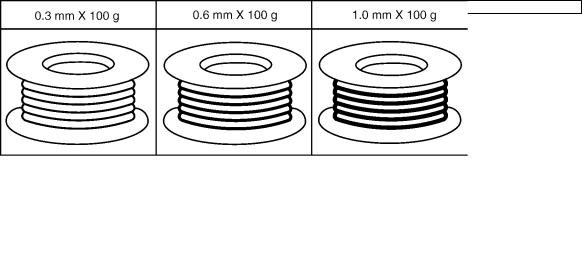
KX-TG2511CA/KX-TG2512CA/KX-TGA250RU
2.2.1.Suggested PbF Solder
There are several types of PbF solder available commercially. While this product is manufactured using Tin, Silver, and Copper (Sn+Ag+Cu), you can also use Tin and Copper (Sn+Cu) or Tin, Zinc, and Bismuth (Sn+Zn+Bi). Please check the manufacturer’s specific instructions for the melting points of their products and any precautions for using their product with other materials.
The following lead free (PbF) solder wire sizes are recommended for service of this product: 0.3 mm, 0.6 mm and 1.0 mm.
2.3.Discarding of P.C. Board
When discarding P. C. Board, delete all personal information such as telephone directory and caller list or scrap P. C. Board.
5
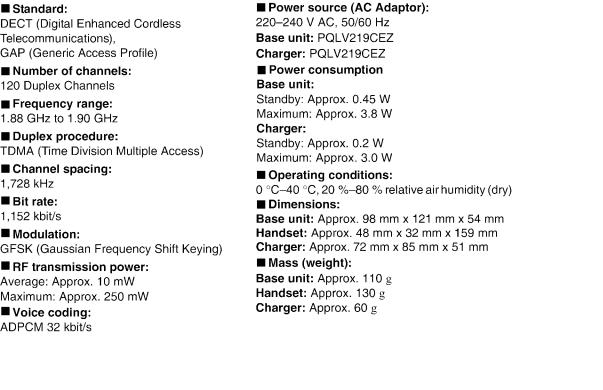
KX-TG2511CA/KX-TG2512CA/KX-TGA250RU
3 Specifications
Note:
• Design and specifications are subject to change without notice.
Note for Service:
•Operation range: Up to 300 m outdoors, Up to 50 m indoors, depending on the condition.
•Analog telephone connection: Telephone Line
6
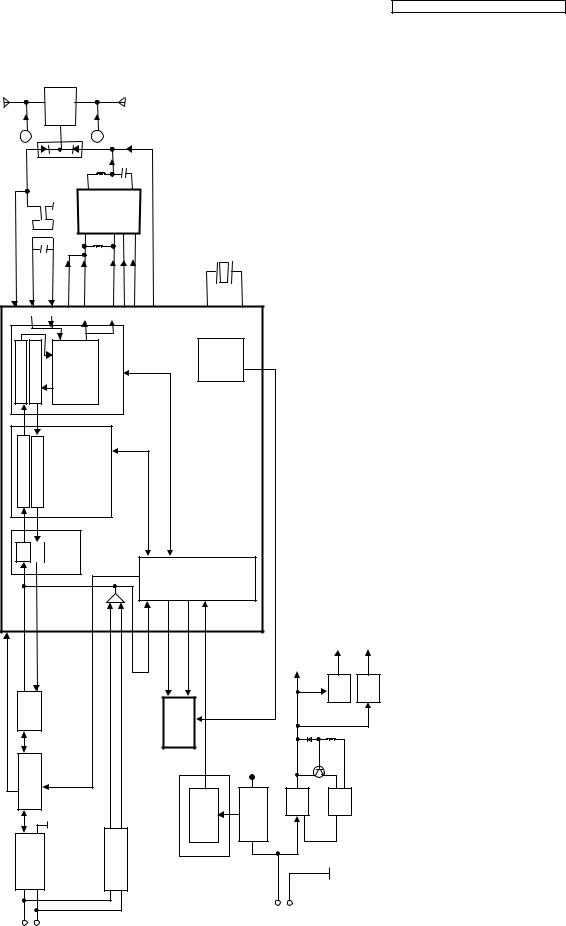
KX-TG2511CA/KX-TG2512CA/KX-TGA250RU
4 Technical Descriptions
4.1.Block Diagram (Base Unit)
|
T1AN |
T1AN |
ANT1 |
T2AN |
T2AN |
ANT2 |
||||||||||||||||||||||
|
6 |
72 |
UNIT) |
|||||||||||||||||||||||||
|
801 |
|||||||||||||||||||||||||||
|
XRon |
XRn |
D |
XTp |
AP FR |
XTn |
LEPS |
XTon |
LATX X1 |
68310 zHM . |
DIAGRAMBLOCK (BASE |
|||||||||||||||||
|
XRp |
VDRAP-VDD |
Pon |
|||||||||||||||||||||||||
|
9 |
801 |
8 |
|||||||||||||||||||||||||
|
IC |
|||||||||||||||||||||||||||
|
4 |
3 6 7 |
||||||||||||||||||||||||||
|
EncodingBurst |
DecodingBurst |
2 |
RF |
PLL |
MOD/DEMOD77 |
BMC |
74 |
80 |
9 |
Charge |
Pump |
10 43 |
TG2511/2512-KX |
||||||||||||||
|
5 |
3 |
75 |
78 |
73 |
|||||||||||||||||||||||
|
Speech Encoding |
Speech Decoding |
ADPCM |
Codec Filter |
DSP |
BBIC |
IC7 |
|||||||||||||||||||||
|
A/D |
D/A |
Analog Front |
End |
||||||||||||||||||||||||
|
CPU |
|||||||||||||||||||||||||||
|
57 |
58 |
44 |
|||||||||||||||||||||||||
|
25 |
18 16 |
23 |
20 |
21 19 |
24 |
V |
V |
||||||||||||||||||||
|
Hook-Off Line Voltage |
BELL |
IC401 SDA |
CONTACT |
2.4 |
1.8 |
||||||||||||||||||||||
|
Switch |
Q4,Q5 |
HOOK |
SCL |
EEPROM |
CHARGE |
2.5V |
3.0 V |
Q9 |
2.4V |
Reg. |
1.8V Reg. |
Q8 |
|||||||||||||||
|
Audio |
MCDIC2 |
||||||||||||||||||||||||||
|
LINETEL |
L1HookBridge |
2L |
Bell/CallerID |
Interface |
(Optional) |
Charge |
Detector |
Limit |
AdaptorACTo |
CPD |
IC3 |
||||||||||||||||
|
Resistor |
|||||||||||||||||||||||||||
|
RectD3 |
|||||||||||||||||||||||||||
|
To |
|||||||||||||||||||||||||||
|
7 |

KX-TG2511CA/KX-TG2512CA/KX-TGA250RU
4.2.Circuit Operation (Base Unit)
4.2.1.Outline
Base Unit consists of the following ICs as shown in Block Diagram (Base Unit) (P.7).
•DECT BBIC (Base Band IC): IC7
—Handling all the audio, signal and data processing needed in a DECT base unit
—Controlling the DECT specific physical layer and radio section (Burst Module Controller section)
—ADPCM code filter for speech encoding and speech decoding (DSP section)
—Echo-cancellation and Echo-suppression (DSP section)
—Any tones (tone, sidetone, ringing tone, etc.) generation (DSP section)
—DTMF receiver (DSP section)
—Clock Generation for RF Module
—ADC, DAC, timer, and power control circuitry
—PLL Oscillator
—Detector
—Compress/Expander
—First Mixer
—All interfaces (ex: RF Power Amp, EEPROM, LED, Analog Front End, etc.)
•RF Power Amp.: IC801
—Amplifier for transmission and reception
•EEPROM: IC401
—Temporary operating parameters (for RF, etc.)
•Additionally,
—Power Supply Circuit (+3.0 V, +2.4 V, +1.8 V output)
—Crystal Circuit (10.368 MHz)
—Charge Circuit
—Telephone Line Interface Circuit
8
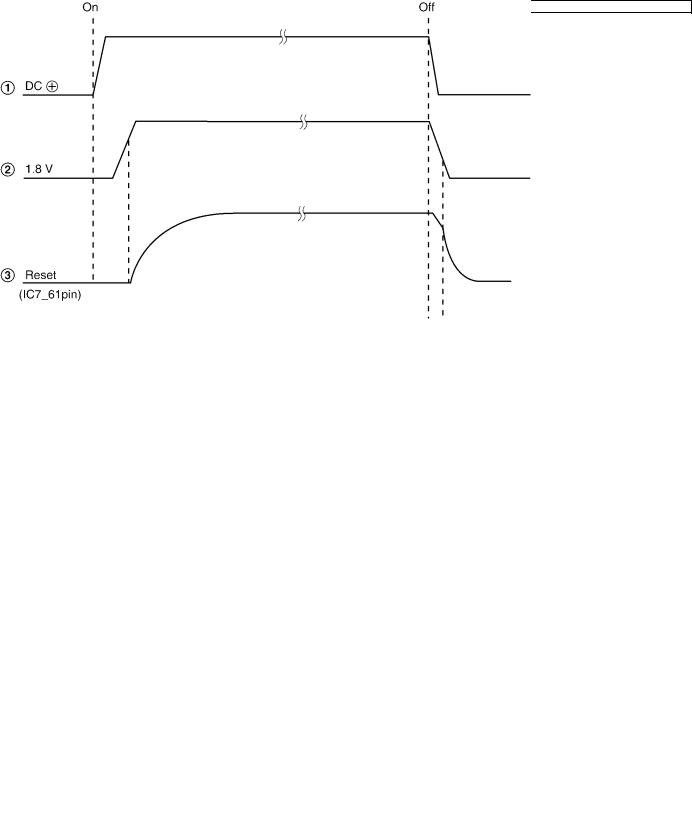
KX-TG2511CA/KX-TG2512CA/KX-TGA250RU
4.2.2.Power Supply Circuit
The power is supplied to the DECT BBIC, RF Module, EEPROM and Charge Contact from AC Adaptor (+6.5 V) as shown in Fig.101. The power supply is as follows;
•DECT BBIC (IC7):
DC Jack (+6.5 V) → IC2 → IC7
DC Jack (+6.5 V) → IC2 → Q9 → IC7 DC Jack (+6.5 V) → IC2 → Q8 → IC7
•RF Power Amp. (IC801):
DC Jack (+6.5 V) → IC2 → IC801 (Power AMP)
•EEPROM (IC401):
DC Jack (+6.5 V) → IC2 → IC7→ IC401
•Charge Contact (TP16):
DC Jack (+6.5 V) → R56 → R55 → D22→ TP16
<Fig.101>
9

KX-TG2511CA/KX-TG2512CA/KX-TGA250RU
4.2.3.Telephone Line Interface
<Function>
•Bell signal detection
•Clip signal detection
•ON/OFF hook circuit
Bell & Clip (: Calling Line Identification Presentation: Caller ID) signal detection:
In the standby mode, Q3 is open to cut the DC loop current and decrease the ring load.
When ring voltage appears at the L1T (A) and L1R (B) leads (when the telephone rings), the AC ring voltage is transferred as follows;
•B → L2 → C4 → R6 → R33 → IC7 Pin 21 (CID INp)
•A → L1 → C3 → R4 → R35 → IC7 Pin 20 (CID INn)
ON/OFF hook circuit:
In the standby mode, Q3 is open, and connected as to cut the DC loop current and to cut the voice signal. The unit is consequently in an on-hook condition.
When IC7 detects a ring signal or press the TALK Key onto the handset, Q4 turns on and then Q3 turns on, thus providing an off-hook condition (DC current flows through the circuit) and the following signal flow makes the loop current.
• B → L2 →D3 → Q3 → Q5 → R21 → R22 → D3 → L1 →A [OFF HOOK]
4.2.4.Transmitter/Receiver
• Audio Circuits and DTMF tone signal circuits.
Base Unit and Handset mainly consist of RF Module and DECT BBIC.
Base Unit and Handset transmit/receive voice signal and data signal through the antenna on carrier frequency.
Signal Path:
*Refer to Signal Route (P.14).
4.2.4.1.Transmitter Block
The voice signal input from the TEL LINE interface goes to RF Power Amp. (IC801) through DECT BBIC (IC7) as shown in
Block Diagram (Base Unit) (P.7)
The voice signal passes through the analog part of IC7 where it is amplified and converted to a digital audio stream signal. The burst switch controller processes this stream performing encryption and scrambling, adding the various other fields to produce the GAP (Generic Access Profile) standard DECT frame, assigning to a time slot and channel etc.
In IC7, the carrier frequency is changing, and frequency modulated RF signal is generated.In IC801,RF signal is amplified, and radiated from antenna. Handset detects the voice signal or data signal in the circuit same as the following explanation of
Receiver Block.
4.2.4.2.Receiver Block
The signal of 1900 MHz band (1881.792 MHz ~ 1897.344 MHz) which is input from antenna is input to IC7 as shown in Block Diagram (Base Unit) (P.7).
In IC7, the signal of 1900 MHz band is downconverted to 864 kHz signal and demodulated, as GAP (Generic Access Profile) standard DECT frames. It passes through the decoding section burst switch controller where it separates out the frame information and performs de-encryption and de-scrambling as required. It then goes to the DSP section where it is turned back
into analog audio. This is amplified by the analog front end, and goes to the TEL LINE Interface.
4.2.5.Pulse Dialling
During pulse dialling the hookswitch (Q3, Q4) is used to generate the pulses using the HOOK control signal, which is set high during pulses. To force the line impedance low during the “pause” intervals between dial pulses, the PULSE_DIAL signal turns on Q2.
10
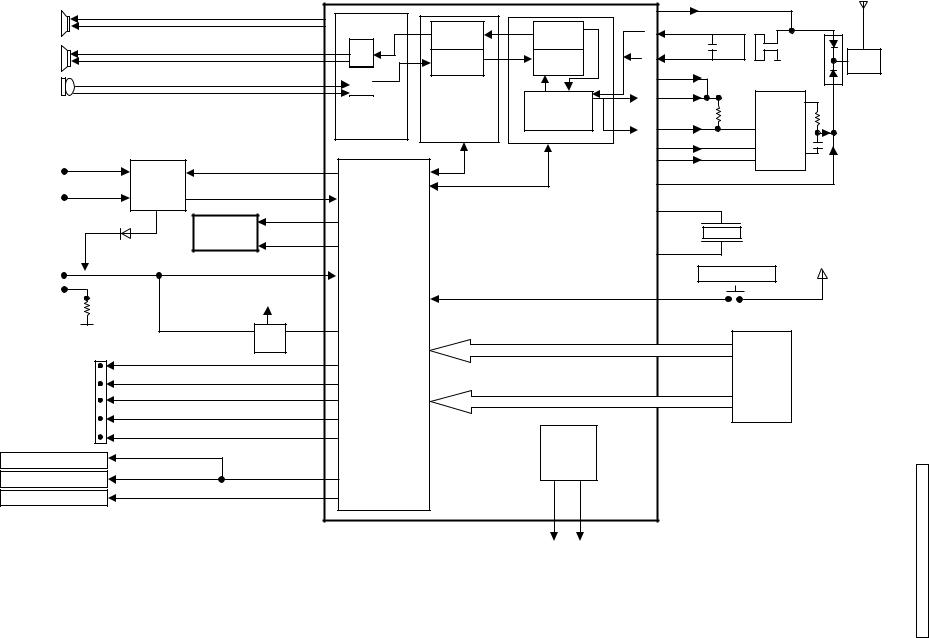
|
.3.4 |
||||||||||||||
|
33 |
5 |
RXon |
Block |
|||||||||||
|
SPEAKER |
RXn |
ANT1 |
||||||||||||
|
35 |
Speech |
Burst |
3 |
|||||||||||
|
15 |
Decoding |
Decoding |
RXp |
|||||||||||
|
RECEIVER |
D/A |
Speech |
Burst |
2 |
DA801 |
|||||||||
|
ANT1 |
Diagram |
|||||||||||||
|
16 |
Encoding |
Encoding |
VDD-PADRY |
|||||||||||
|
75 |
||||||||||||||
|
MIC |
19 |
A/D |
ADPCM |
TXp |
||||||||||
|
20 |
RF |
77 |
4 |
|||||||||||
|
Analog |
Codec |
9 |
||||||||||||
|
PLL |
||||||||||||||
|
Front |
Filter |
TXn |
RF PA |
|||||||||||
|
MOD/DEMOD |
||||||||||||||
|
End |
DSP |
BMC |
78 |
3 |
||||||||||
|
CHARGE(-) |
SCL |
57 |
Pon |
IC801 |
(Handset) |
|||||||||
|
X1 |
||||||||||||||
|
CHARGE(+) |
CHARGE |
32 |
73 |
PSEL |
6 |
8 |
||||||||
|
74 |
7 |
|||||||||||||
|
CHARGE |
CHARGE |
80 |
TXon |
|||||||||||
|
CIRCUIT |
CHARGE_CTRL |
31 |
||||||||||||
|
CONTACTS |
Q4, Q9, R7 |
9 |
XTAL |
|||||||||||
|
EEPROM |
58 |
10.368 |
||||||||||||
|
D7 |
IC3 |
SDA |
||||||||||||
|
10 |
MHz |
|||||||||||||
|
BATT+ |
BATTERY |
|||||||||||||
|
VBAT |
36 |
|||||||||||||
|
BATTERY |
ON SWITCH |
|||||||||||||
|
11 |
||||||||||||||
|
TERMINAL |
CPU |
44 |
||||||||||||
|
BATT- |
R45 |
1.8 V |
||||||||||||
|
13 |
||||||||||||||
|
1.8 V |
LDO_CTRL |
48, 49, 50, 51 |
ROWS |
|||||||||||
|
Q2 |
||||||||||||||
|
CD |
56 |
|||||||||||||
|
RESET |
66 |
22, 23, 24, 25, 26 |
COLUMNS |
KEYPAD |
||||||||||
|
CSB |
63 |
|||||||||||||
|
LCD |
||||||||||||||
|
SDA |
54 |
|||||||||||||
|
SCL |
55 |
|||||||||||||
|
BBIC |
Charge |
|||||||||||||
|
LCD-BACK LIGHT |
52 |
IC1 |
Pump |
|||||||||||
|
KEY LED |
||||||||||||||
|
43 |
42 |
|||||||||||||
|
BELL LED |
68 |
|||||||||||||
|
CP3.0V CP4.0V |
KX-TGA250 BLOCK DIAGRAM (HANDSET)
TGA250RU-TG2512CA/KX-TG2511CA/KX-KX
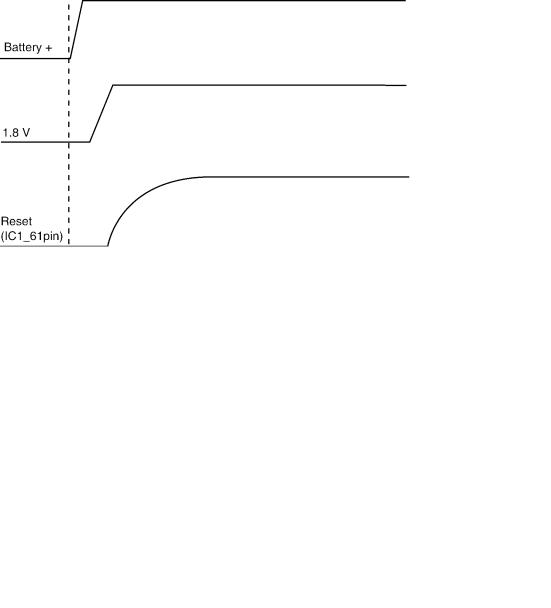
KX-TG2511CA/KX-TG2512CA/KX-TGA250RU
4.4.Circuit Operation (Handset)
4.4.1.Outline
Handset consists of the following ICs as shown in Block Diagram (Handset) (P.11).
•DECT BBIC (Base Band IC): IC1
—All data signals (forming/analyzing ACK or CMD signal)
—All interfaces (ex: Key, Detector Circuit, Charge, DC/DC Converter, EEPROM, LCD, RF Power Amp.)
—PLL Oscillator
—Detector
—Compress/Expander
—Reception
•RF Power Amp: IC801
—Amplifier for transmission
•EEPROM: IC3
—Temporary operating parameters (for RF, etc.)
4.4.2.Power Supply Circuit/Reset Circuit
Circuit Operation:
When power on the Handset, the voltage is as follows;
BATTERY(2.2 V ~ 2.6 V: BATT+) → F1 → Q2 (1.8 V), IC1-43pin (2.5V)
The Reset signal generates IC1 (61 pin) and 1.8 V.
4.4.3.Charge Circuit
Circuit Operation:
When charging the handset on the Base Unit, the charge current is as follows;
DC+(6.5 V) → R56 → R55 → D22 → CHARGE+(Base) → CHARGE+(Handset) → Q4 → D7→ F1 → BATTERY+… Battery…
BATTERY- → R45 → GND → CHARGE-(Handset)→ CHARGE-(Base) → GND → DC-(GND) In this way, the BBIC on Handset detects the fact that the battery is charged.
The charge current is controlled by switching Q9 of Handset. Refer to Fig.101 in Power Supply Circuit (P.9).
4.4.4.Battery Low/Power Down Detector
Circuit Operation:
“Battery Low” and “Power Down” are detected by BBIC which check the voltage from battery. The detected voltage is as follows;
•Battery Low
Battery voltage: V(Batt)  2.25 V ± 50 mV
2.25 V ± 50 mV
The BBIC detects this level and « » starts flashing.
» starts flashing.
•Power Down
Battery voltage: V(Batt)  2.0 V ± 50 mV The BBIC detects this level and power down.
2.0 V ± 50 mV The BBIC detects this level and power down.
4.4.5.Speakerphone
The hands-free loudspeaker at SP+ and SPis used to generate the ring alarm.
12
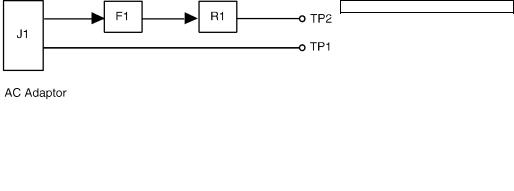
KX-TG2511CA/KX-TG2512CA/KX-TGA250RU
4.5.Circuit Operation (Charger Unit)
4.5.1.Power Supply Circuit
The power supply is as shown.
13

KX-TG2511CA/KX-TG2512CA/KX-TGA250RU
4.6.Signal Route
14

KX-TG2511CA/KX-TG2512CA/KX-TGA250RU
5 Location of Controls and Components
Refer to the Operating Instructions.
Note:
You can download and refer to the Operating Instructions (Instruction book) on TSN Server.
6 Installation Instructions
Refer to the Operating Instructions.
Note:
You can download and refer to the Operating Instructions (Instruction book) on TSN Server.
7 Operating Instructions
Refer to the Operating Instructions.
Note:
You can download and refer to the Operating Instructions (Instruction book) on TSN Server.
7.1.For Service Hint
15
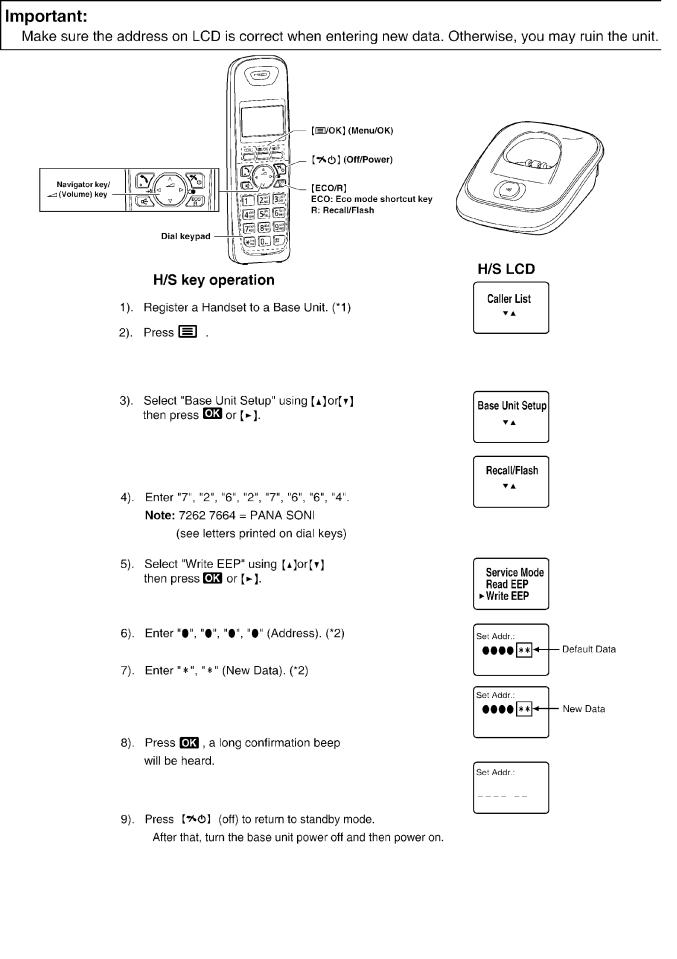
KX-TG2511CA/KX-TG2512CA/KX-TGA250RU
8 Service Mode
8.1.Engineering Mode
8.1.1.Base Unit
16

KX-TG2511CA/KX-TG2512CA/KX-TGA250RU
Frequently Used Items (Base Unit)
ex.)
|
Items |
Address |
Default Data |
New Data |
Remarks |
|
|
C-ID (FSK) sensitivity |
04 8B |
00 |
01 (6 dB up) |
02 (12 dB up) |
When hex changes from “00” to “01” or “02”, |
|
gain increases by 6 dB or 12 dB. |
|||||
|
Frequency |
00 08/00 07 |
02/70 |
— |
— |
Use these items in a READ-ONLY mode to |
|
confirm the contents. Careless rewriting may |
|||||
|
ID |
00 02~00 06 |
Given value |
— |
— |
|
|
cause serious damage to the computer system. |
|||||
|
Bell length |
02 18 |
32 (5sec) (*3) |
1E (3 sec) |
14 (2 sec) |
This is time until bell stops ringing. |
|
(Unit: 100 ms) |
|||||
|
PULSE Dial speed |
01 F8 |
28 (40msec) |
14 (20msec) |
— |
This is pulse make time. (Unit:1 ms) |
|
(10PPS -> 20PPS) |
(*3) |
||||
|
01 F9 |
3C (60msec) |
1E (30msec) |
— |
This is pulse break time. (Unit:1 ms) |
|
|
(*3) |
|||||
|
02 07 |
57 (870msec) |
2C (440msec) |
— |
This is inter-digit time in pulse mode. |
|
|
(*3) |
(Unit:10 ms) |
||||
Note:
|
(*1) |
Refer to Registering a Handset to a Base Unit in the Operating Instructions. |
||||||
|
(*2) |
When you enter the address or New Data, please refer to the table below. |
||||||
|
Desired Number (hex) |
Input Keys |
Desired Number (hex) |
Input Keys |
||||
|
0 |
0 |
A |
[R] + 0 |
||||
|
1 |
1 |
B |
[R] + 1 |
||||
|
. |
. |
C |
[R] + 2 |
||||
|
. |
. |
||||||
|
D |
[R] + 3 |
||||||
|
. |
. |
E |
[R] + 4 |
||||
|
9 |
9 |
F |
[R] + 5 |
||||
|
(*3) |
|||||||
|
Bell length |
32(hex) = 50(dec) → 50 × 100 msec = 5000 msec (5 sec) |
||||||
|
PULSE Dial speed |
28(hex) = 40(dec) → 40 × 1msec = 40msec |
||||||
|
(10PPS -> 20PPS) |
|||||||
|
3C(hex) = 60(dec) → 60 × 1msec = 60msec |
|||||||
|
57(hex) = 87(dec) → 87 × 10msec = 870msec |
17
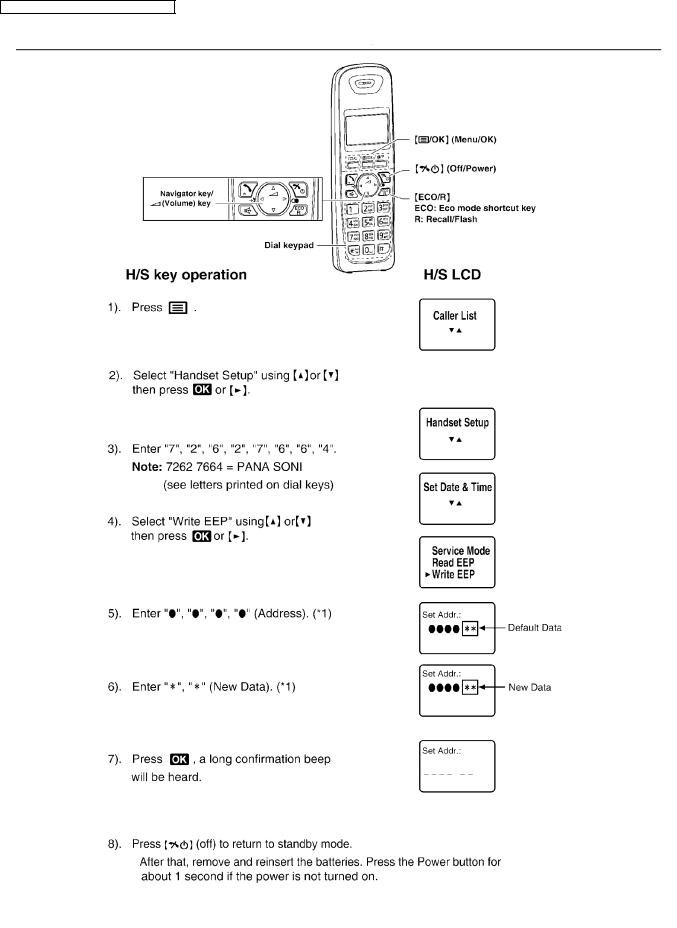
KX-TG2511CA/KX-TG2512CA/KX-TGA250RU
8.1.2.Handset
18

KX-TG2511CA/KX-TG2512CA/KX-TGA250RU
Frequently Used Items (Handset)
ex.)
|
Items |
Address |
Default Data |
New Data |
Possible Adjusted |
Possible Adjusted |
Remarks |
|
Value MAX (hex) |
Value MIN (hex) |
|||||
|
Sending level |
03 17 |
Adjusted value |
Given value |
F3 |
F3 |
(*2) |
|
Receiving level |
03 18 |
Adjusted value |
Given value |
DB |
DB |
(*3) |
|
Battery Low |
00 04 |
70 |
— |
— |
— |
(*4) |
|
Frequency |
00 02/00 01 |
02/70 |
— |
— |
— |
|
|
ID |
00 10~00 14 |
Given value |
— |
— |
— |
Note:
(*1) When you enter the address or New Data, please refer to the table below.
|
Desired Number (hex.) |
Input Keys |
Desired Number (hex.) |
Input Keys |
|
|
0 |
0 |
A |
[R] + 0 |
|
|
1 |
1 |
B |
[R] + 1 |
|
|
. |
. |
C |
[R] + 2 |
|
|
. |
. |
D |
[R] + 3 |
|
|
. |
. |
|||
|
E |
[R] + 4 |
|||
|
9 |
9 |
F |
[R] + 5 |
(*2) When adding “01” (hex) to default value, sending level increases by 0.25 dB. ex.)
|
Item |
Default Data |
New Data |
|
|
E7 |
EB |
E3 |
|
|
Sending level |
-2.5dBm |
-1.5dBm |
-3.5dBm |
(*3) When reducing “01” (hex) from default value, receiving level increases by 0.25 dB. ex.)
|
Item |
Default Data |
New Data |
|
|
E7 |
EB |
E3 |
|
|
Receiving level |
-23dBm |
-22dBm |
-24dBm |
(*4) Use these items in a READ-ONLY mode to confirm the contents. Careless rewriting may cause serious damage to the handset.
19

KX-TG2511CA/KX-TG2512CA/KX-TGA250RU
8.2.Copying Phonebook Items when Repairing
You can copy the handset phonebook to another (compatible Panasonic) handset. This will help to save the original phonebook data which the customer has registered.
Available models: KX-TG2511/KX-TG2512 Refer to the following procedures.
Note:
•BS=Base Unit, HS=Handset
•If the max number of handsets are already registered to the base unit, a new handset cannot be registered.
•To register the handset, refer to Registering a Handset to a Base Unit in the Operating Instructions.
•To cancel the handset, refer to Deregistering a Handset in the Operating Instructions.
•To copy the handset phonebook, refer to Copying Phonebook Entries in the Operating Instructions.
20
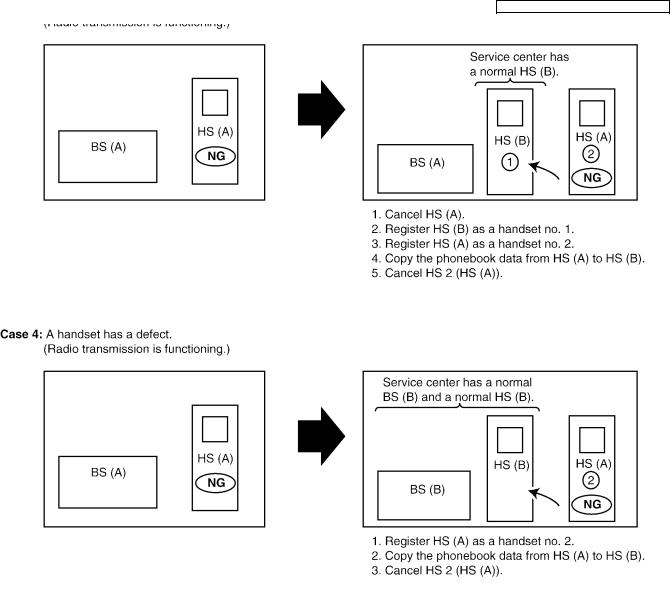
KX-TG2511CA/KX-TG2512CA/KX-TGA250RU
Note:
•BS=Base Unit, HS=Handset
•If the max number of handsets are already registered to the base unit, a new handset cannot be registered.
•To register the handset, refer to Registering a Handset to a Base Unit in the Operating Instructions.
•To cancel the handset, refer to Deregistering a Handset in the Operating Instructions.
•To copy the handset phonebook, refer to Copying Phonebook Entries in the Operating Instructions.
21
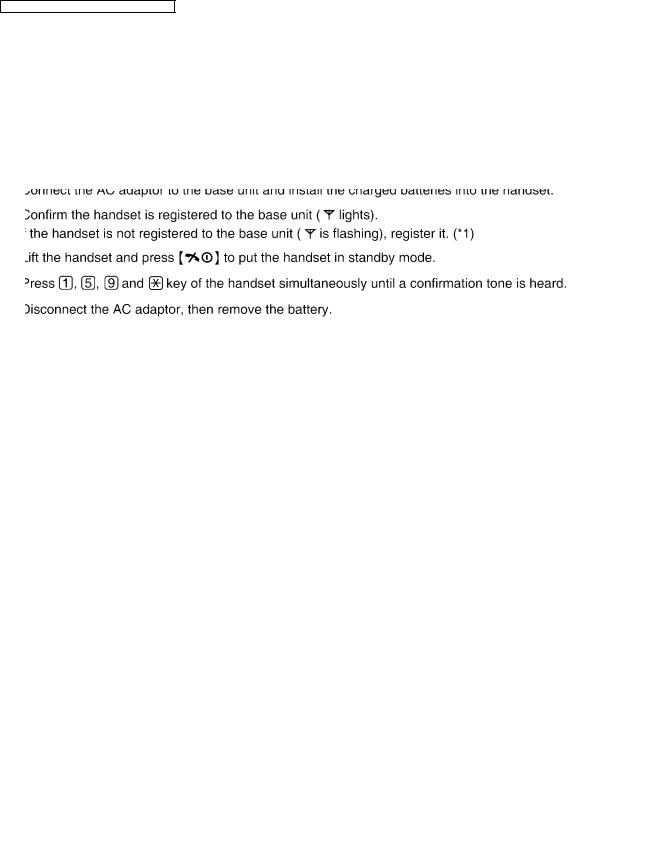
KX-TG2511CA/KX-TG2512CA/KX-TGA250RU
8.3.How to Clear User Setting
Units are reset to the Factory settings by this operation (Erase stored Phone numbers, Caller list and etc.)
Note:
•Some menus are not reset. Refer to Operating Instructions (P.15).
•The reset menus differ depending on the following operations.
•This operation should not be performed for a usual repair.
8.3.1.Resetting both base unit and handset
Both the base unit and the registered handset which you did the following steps  to
to  are reset. Other registered handsets will not be reset.
are reset. Other registered handsets will not be reset.
Note:
(*1) Refer to Registering a Handset to a Base Unit in the Operating Instructions.
8.3.2.Resetting only handset
The only handset is reset by doing the following steps  to
to  .
.
Note: (*2)
•The handset registration to the base unit is cancelled.
•If the handset needs to be registered to the base unit, refer to Registering a Handset to a Base Unit in the Operating Instructions.
•If users do not bring the base unit with them, the registration procedure has to be done by users themselves.
22
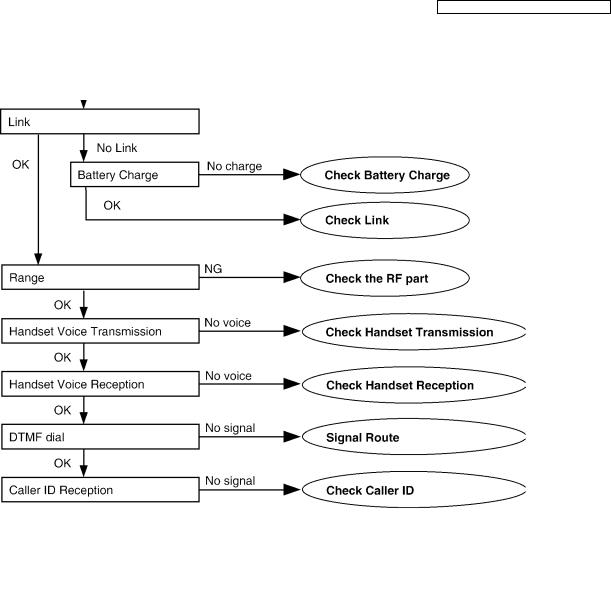
KX-TG2511CA/KX-TG2512CA/KX-TGA250RU
9 Troubleshooting Guide
9.1.Troubleshooting Flowchart
Flow Chart
Cross Reference:
Check Power (P.24)
Bell Reception (P.34)
Check Battery Charge (P.25)
Check Link (P.26)
Check the RF part (P.30)
Check Handset Transmission (P.33)
Check Handset Reception (P.33)
Signal Route (P.14)
Check Caller ID (P.33)
23
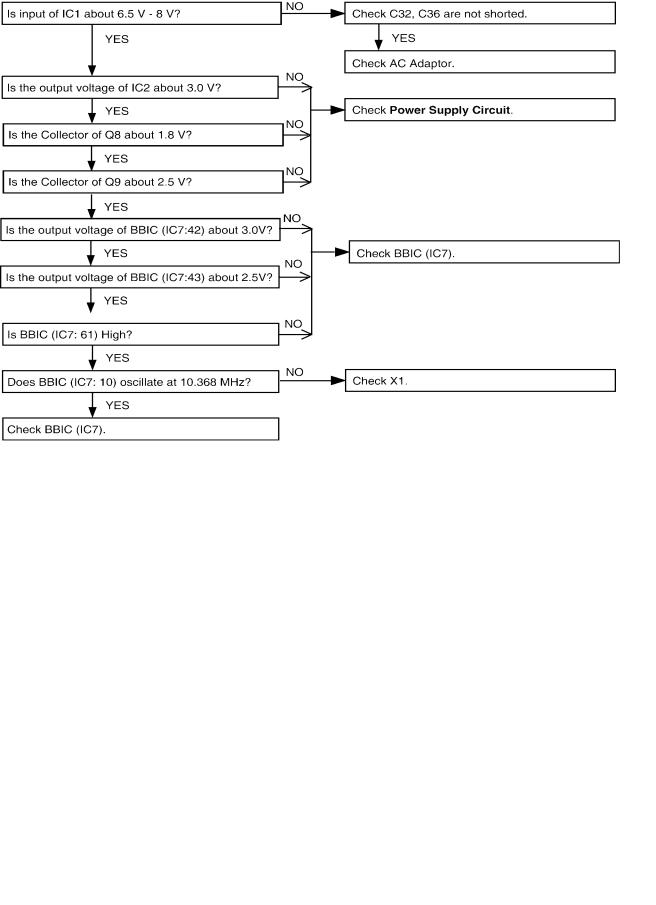
KX-TG2511CA/KX-TG2512CA/KX-TGA250RU
9.1.1.Check Power
9.1.1.1.Base Unit
Is the AC Adaptor inserted into AC outlet? (*1)
|
Cross Reference: |
Note: |
|
Power Supply Circuit (P.9) |
(*1) Refer to Specifications (P.6) for part number and |
|
supply voltage of AC Adaptor. |
9.1.1.2.Handset
Cross Reference:
Power Supply Circuit/Reset Circuit (P.12)
24
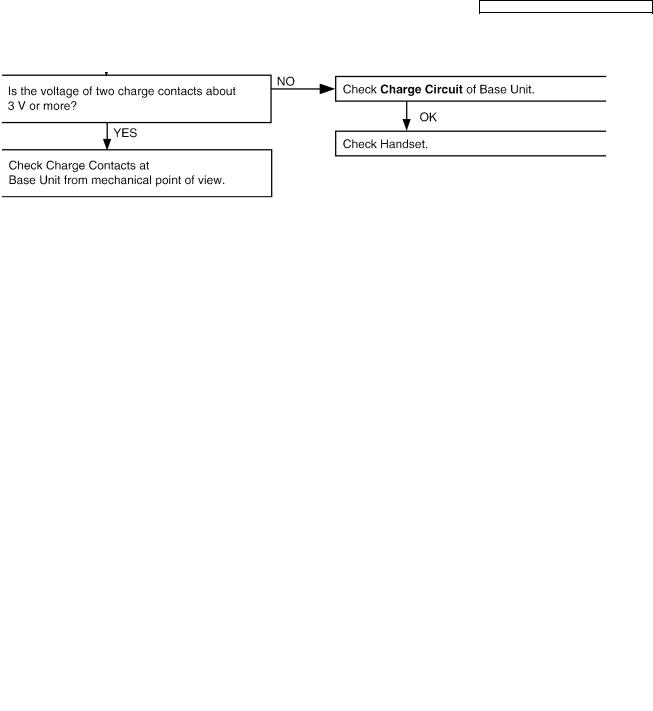
KX-TG2511CA/KX-TG2512CA/KX-TGA250RU
9.1.2.Check Battery Charge
9.1.2.1.Base Unit
Cross Reference:
Charge Circuit (P.12)
9.1.2.2.Handset
Cross Reference:
Check Power (P.24)
Charge Circuit (P.12)
9.1.2.3.Charger Unit
Cross Reference:
Charge Circuit (P.12)
25
 Loading…
Loading…
DOWNLOAD Panasonic KX-TG2511RUW / KX-TGA250RUW Service Manual ↓ Size: 1.13 MB | Pages: 7 in PDF or view online for FREE
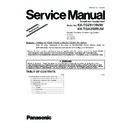
- Model
- KX-TG2511RUW KX-TGA250RUW
- Pages
- 7
- Size
- 1.13 MB
- Type
- Document
- Service Manual / Supplement
- Brand
- Device
- Telephone / DIGITAL CORDLESS ANSWERING SYSTEM
- File
- kx-tg2511ruw-kx-tga250ruw.pdf
- Date
- 2018-11-20
ORDER NO: KM41402422SE
Telephone Equipment
Model No.
KX-TG2511RUW
KX-TGA250RUW
Digital Cordless Answering System
W: White
(for Russia)
(for Belarus)
Subject : Adding KX-TG2511RUW to the KX-TG2511RU Series.
Note: other information is the same as KX-TG2511RU Service Manual (Order No.
KM41006115CE). You can download and refer the Service Manual on TSN Server.
TABLE OF CONTENTS
PAGE
PAGE
1 Exploded View and Replacement Parts List ———— 2
1.4.1. Base Unit ———————————————— 5
1.4.2. Handset ————————————————- 6
1.4.3. Accessories ——————————————— 7
1.4.4. Screws————————————————— 7
1.4.5. Fixtures and Tools ———————————— 7
Supplement-7
Please file and use this supplement manual together with the service manual for Model No.KX-
TG2511RUM/KX-TG2511RUN/KX-TG2511RUS/KX-TG2511RUT/KX-TG2512RUN/KX-TG2512RUS/KX-
TG2521RUT/KX-TGA250RUM/KX-TGA250RUN/KX-TGA250RUS/KX-TGA250RUT, Order No.KM41006115CE.
2
KX-TG2511RUW/KX-TGA250RUW
1 Exploded View and Replacement Parts List
1.1.
Cabinet and Electrical Parts (Base Unit)
PCB1
E1
4
1
2
3
6
5
6
7(*1)
9
A
8
Ref.No.
Figure
A
2.6 x 8 mm
3
KX-TG2511RUW/KX-TGA250RUW
1.2.
Cabinet and Electrical Parts (Handset)
Note:
(*1) This cable is fixed by attaching.
(*2) The rechargeable Ni-MH battery HHR-4MVE is available through sales route of Panasonic.
(*3) Attach the spacer (No. 114) to the exact location described above.
102
103
104
E103
E105
E102
E101(*1)
111
115
116
105
106
110
113
B
(*2)
118
120
119 (*3)
101
109
E104
112
B
E107
MIC100
PCB100
108
B
117
114
107
Spacer (No.119)
Battery cover
Put it in the center.
Stick it between
ribs.
Ref.No.
2
8 mm
B
Figure
4
KX-TG2511RUW/KX-TGA250RUW
1.3.
Accessories
A2
A1
